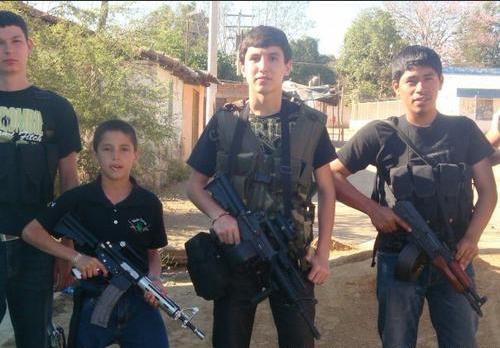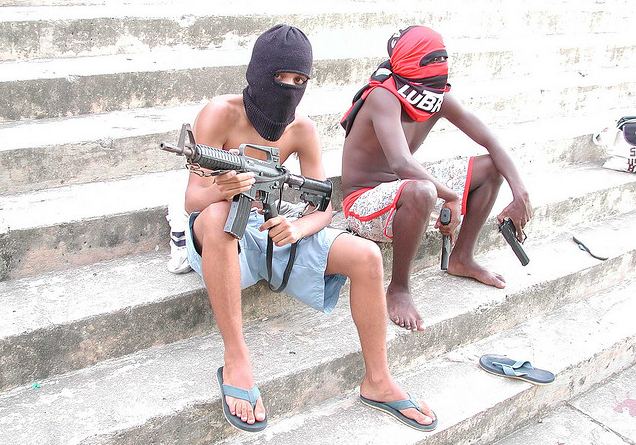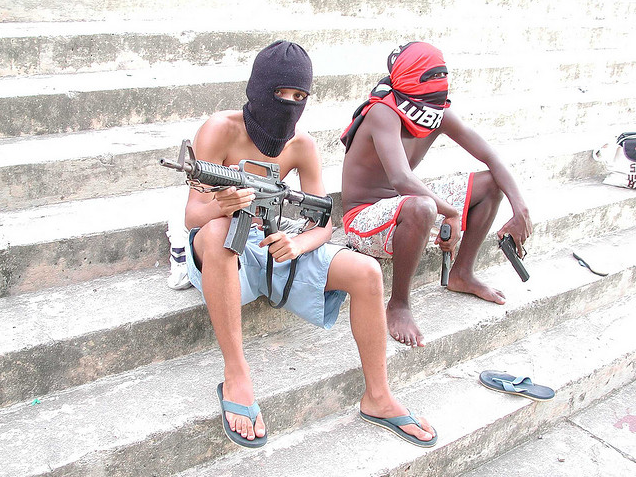From Cradle to Conflict: Child Soldiers’ Growing Role in Latin America’s Drug Wars
Approximately 300,000 children around the globe have been recruited as child soldiers. These children are forced to enter “various armed groups, civil militia, paramilitaries and government armed forces.” According to the United Nations’ Convention on the Rights of a Child, any person under the age of 18 years unless under specific law is considered a child. In accordance with international law, it is illegal for a child under the age of 18 to actively participate in the armed forces of their country, and the recruitment of a child under the age of 15 is deemed a “war crime.” A child soldier is deemed as anyone ” under eighteen years of age, who is part of any kind of regular or irregular armed force, any group serving in any military capacity, including, but not necessarily limited to: cooks, porters, messengers, and anyone accompanying such groups other than family members.” Young girls and boys are also noted to be recruited “for forced sexual purposes and/or forced marriage,” and are often times trafficked.[FS1] Although this age limit is moderately new (created in 2002 by the Optional Protocol to the Convention of the Rights of a Child), this decadent practice stills occurs in different parts of the world, particularly in Africa, Asia, and Latin America. It is important to highlight the fact that prior to the above-cited protocol passed in 2002, the minimum age for participating in the armed conflict was fifteen, according to the 1949 Geneva Convention and the 1977 additional protocols. However, critics have insisted that cultural standards of maturity must be taken into consideration when reporting on cases of child soldiers. In Africa and the Middle East, for example, the age gap for the “transition from the dependence of childhood to the independence of adulthood” is between the years of 15 and 24. Despite this spread, it has been reported that “nearly 80 percent of the conflicts involving child soldiers, include combatants below the age of fifteen, with some as young as seven or eight,” clearly well below the formal minimum age of consent to willingly participate.

Brief History of the Oxymoron “Child Soldier”
Child soldiers and combatants have been encountered on battlefields throughout history. One of the most prominent instances of this is the Hitlerjugend (Hitler Youth) that was formed during the last phase of World War II. However, this phenomenon has transformed over time in which the magnitude of children on and off the battlefield has risen drastically. Although there are several factors that are responsible for this surge, it is important to pinpoint what the main causes for these developments tend to be. Firstly, because of the deterioration of social structures in modern conflict zones or in overcrowded slums, many children who have become orphans are vulnerable to indoctrination as agents of change. Such targets are easily recruited or volunteer as a means of survival. Secondly, with the evolution of and the widespread availability of weaponry, small arms and other light weapons now roam the streets and byways of the world and are trafficked at an alarming rate across borders. This impacts children in armed factions and gangs as they now learn how to use these lighter lethal weapons easier which allows them to carry such weapons for longer periods of time[FS2]. Warlords and gangs typically utilize children because they are easily manipulated, effective, cheap, ignorant to the real costs of things[FS3] , as well as expendable, particularly in developing regions like Latin America. Child soldiers are also able to adapt quicker to adverse circumstances and situations, and often unnoticed, they can bypass police forces. This latter type of child soldier is now the focus the western hemisphere as the region struggles to contain record levels of gang violence and drug trafficking.
Though a large number of these children “volunteer” to enlist, child soldiers are usually abducted from their homes, schools, villages or streets. Such victims characteristically are deprived of recreational activities, education, and communication with family and friends, as well as basic liberties. After continuous exposure to violence as well as psychological trauma, these children are robbed of their innocence. The most common forms of exploitation of child soldiers include, but are not limited to: “to clear or lay landmines, [act] as servants, porters, messengers, spies, or placed in combat situations.”[1] Children are also used as suicide bombers as they tend to be tenacious in conflict when compelled by religious, political, and ideological zeal. Often, children are drugged to facilitate the mentality required for conflict and to prevent them from going M.I.A. This is specifically common among girls as, although they can be used for combat, sexual exploitation tends to be the norm, and they tend to be drugged often since they are subjected to rape, gang rape, and forced servitude. [FS4] Although one gender does not suffer more than the other, young girls have a greater risk when it comes to physical and psychological harm as they expected to be infected with HIV/AIDS and other STDs, as well as forced and inhumane abortions.
The media focus of late has been on child soldiers in Africa, given the viral spread of the Kony 2012 media campaign that aims to make the most wanted war criminal, according to the International Criminal Court (ICC), famous. To make the invisible visible, it is important to not only communicate the full extent of the child soldier phenomenon in Africa, but also in regions like Latin America, where it has been estimated that “some 14,000 children, or “little bees” as they are known to the paramilitaries, serve in combat, make and deploy mines, and gather intelligence” as well as commit atrocious human rights violations in countries like Colombia.[2] The countries with a notorious history of child soldier recruitment in the Latin American region are Colombia, where children enlisted voluntarily in the Revolutionary Armed Forces of Colombia (FARC) and the National Liberation Army (ELN) for economic reasons, Mexico, Brazil and the trifecta murder capitals (El Salvador, Guatemala and Honduras). Emphasis will be put on the last three, who are deeply stricken by violence, organized gangs and the recruitment of children.
Mexico
The use of children and adolescents by numerous drug gangs and cartels is commonplace in Mexico, a country afflicted by constant narcotic related violence. Children that are recruited to serve in gangs are typically known as “narco juniors”, who are used as mules to smuggle drugs across borders, as well as – “sicaritos” which means child assassins and are used particularly by the paramilitary organization Los Zetas. [FS5] According to a CNN report, the Gulf Cartel “has recruited U.S. teenagers as young as 13 to carry out its enforcement hits on the north side of the border.”[3] Furthermore, NPR has also recounted that “cartels have begun seeking younger and younger recruits”[4] where most of “the gunmen – teenagers among them – will saunter in and indiscriminately spray the room with AK-47 assault rifles, hitting both their targets and innocent bystanders.”[5] Many Mexican drug cartels have chosen to recruit children for the same reasons some of those in Africa do – a sense of fearlessness which normally manifests itself from their inevitable lack of maturity. Many of these children who are being lured into the dark opportunities of gang and paramilitary lifestyles, do so for a number of reasons. Living in poverty stricken areas, a lot of children are lured into such organizations because of mixed dosages of monetary incentives, respect, and a sense of family, community, and security.

A major problem bedeviling this child soldier phenomenon – particularly in Mexico – is the fact that it is beginning to spread to affect children in nearby countries – such as the United States and other neighboring Latin American countries. According to various reports, “the number of children from the United States being recruited by the cartels has risen since the second half of 2011 because they enjoy the benefit of citizenship.” [6] Most of them are former members of gangs operating in the U.S. and tend to be more fearless when proving their new-found loyalty to the cartels to which they now belong to in Mexico, usually through such tasks as drug trafficking, extortion, blackmail, kidnapping, piracy and even spying. In fact, the latter task is vital for cartels that need intelligence on police forces and other gangs operating in their areas. Here, kids are used as “expendables” that assist these gangs with vital secrets, which reportedly are “responsible for tens of thousands of death[s] in the gruesome violence of the Mexican drug war.”[7]
El Salvador, Guatemala and Honduras: Trifecta of Highest Murder Rates
Gangs have infested the very backbone of local communities throughout Central America. This is of particular interest to the countries of Guatemala, Honduras, and now El Salvador, countries, which together exhibit some of the highest murder rates per capita in the world. Recent reports have not only exposed the violence imposed by gangs, but also the alarming involvement of children, where even schools have become a dangerous zone for recruitment, murder and extortion. In countries like El Salvador, it has been noted that “teachers are intimidated into paying renta or protection money to neighborhood gang members from each paycheck” as well as the students themselves, who are now having to “pay the gangs a quarter a day to be able to study” in peace.[8] Accordingly, the homicide rate in El Salvador has skyrocketed to over 66 per 100,000 inhabitants today, where the majority of perpetrators are found to be children under the age of 18.[9] Surprisingly, some gang leaders are as young as 16 and recruit children from 9 years of age to do their “dirty” work. A major problem in this region, like in most developing countries, is poverty and the lack of job and educational opportunities presented to impoverished youth. For instance, youth who are from particular “barrios” (neighborhoods) tend to withhold information on where they are from because some potential employers refrain from hiring people from some of the most notorious barrios, for security reasons.[10]
Public Safety is another important consideration. As mentioned before, many children are lured into the gang world because they do not have a stable family or sense of safety or solidarity. In countries like Honduras where, in spite of recommendations by the United Nations that a country their size should field a police force close to 4,000, they only have 1,000 police officers on duty, one can see how this presents a problem in maintaining law and order within communities.[11] In Honduras, this is specifically important as Tegucigalpa has been named one of the murder capitals of the world, and hundreds of children have been coerced into killing others and also themselves been casualties of gang warfare. Therefore, one can see that if the social problems of poverty, security, and economic opportunities are not addressed, particularly in countries like Honduras, El Salvador, Guatemala, Belize and Panama – all of which had “higher per-capita murder rates than even was the case in Mexico in 2010,” the chronic use of marginalized children in illicit activities will continue to become devastatingly widespread.
Brazil
Similar to Central American barrios, hundreds of thousands of homeless street children roam the favelas (slums), and urban streets throughout Brazil. These children, often uneducated with little or no family, turn towards gangs as a means of survival. More often than not, gang leaders are seen as role models for the children of the favelas with power and money – a concept that can be very alluring to a child who has nothing and faces the constant threat of police violence, death squads, rival gang violence, as well as random killings. Gangs often recruit these vulnerable children because there are plenty who are desperately willing to make a living through illegal means in order to obtain money, power, protection and family ties. These children are also targeted because once in court, they receive short jail terms when caught by the police and have few inhibitions to reduce their effectiveness as street warriors. Nonetheless, it is also important to note that not all gangs are made up of impoverished children. It has been stated that in some cases in Brazil, wealthy adolescents with expensive drug habits have also created their own gangs and commit crimes such as property theft,[12] in order to sponsor their alternative lifestyle. According to the Chief Justice of Rio de Janeiro’s juvenile court, Guaraci de Campos Viana, drug mafias recruit children as young as nine, and do so because they “have no sense of danger [.. and that] being a member of a drug gang gives them a sort of adrenaline rush,” as well as purpose.[13] Predominantly in Rio de Janeiro, these children “are waging war on behalf of drug gangs to extend or secure control of the cities’ favelas—300 of 700 of which are controlled by gangs.[14] Accordingly, the term “urban child soldier” has been used to describe such children as “children and youth employed or otherwise participating in organized armed violence where there are elements of a command structure and power over territory, local population as well as resources. Organized armed groups include institutionalized street gangs, maras, and pandillas, drug factions, ethnic militias, vigilantes and even paramilitary groups acting in non-war scenarios.”[15] This new term reflects the change in direction of the historic “child soldier” who once took arms in the battlefields throughout historical wars, and now shows their participation in the deadly ongoing violence meted out by organized gangs and criminal groups in the streets and neighborhoods of civilians.
Conclusion
The use of children in violent wars, once present upon the battlefields, is now occurring on the urban streets and local communities at an increasing rate, which now have international implications. To use minors in armed conflict and organized groups not only violates local, national, regional and international laws, but is also a gross violation of human rights and ethics. Children are often lured into gang life in regions like Latin America for numerous factors such as: poverty, security, lack of education and employment, as well as the erosion of other systematic institutions. Here, children are used in the pursuit of power, money, territory, and respect for the criminal institutions that utilize children’s vigor, vulnerability, innocence and age to their benefit. Today you see children bearing weapons such as semiautomatic guns, taking to the public streets to carry out internal and urban gang wars. Unless government authority on both a local international dimension pay attention to the growing number of children caught in the fire of gang fights and drug wars, this problem will continue to flourish and inevitably spill into other surrounding countries like the United States and the Caribbean region. It is important that governments allocate funds to not only take children off the streets, but also to create preventative programs and awareness campaigns targeting at educating at risk children. Although these are good steps in the direction of ending child soldiers, it is simply not enough. Governments need to partner with both public/private and nongovernmental organizations to help demobilize and reintegrate those children with their already deeply affected lives, back into civil society. This includes not only access to basic needs such as shelter, protection, food and water, but also to physical and psychological treatment and rehabilitation environments. Also, socio-political factors such as poverty, educational and economic opportunities must be analyzed and improved so that future children are not tempted by the gang life to make up for what their families and societies lack. Furthermore, a strong support system will be absolutely essential to provide the aid to these children who will have to face challenges on a daily basis for the rest of their lives.
To view sources, please click here.
Please accept this article as a free contribution from COHA, but if re-posting, please afford authorial and institutional attribution. Exclusive rights can be negotiated.



